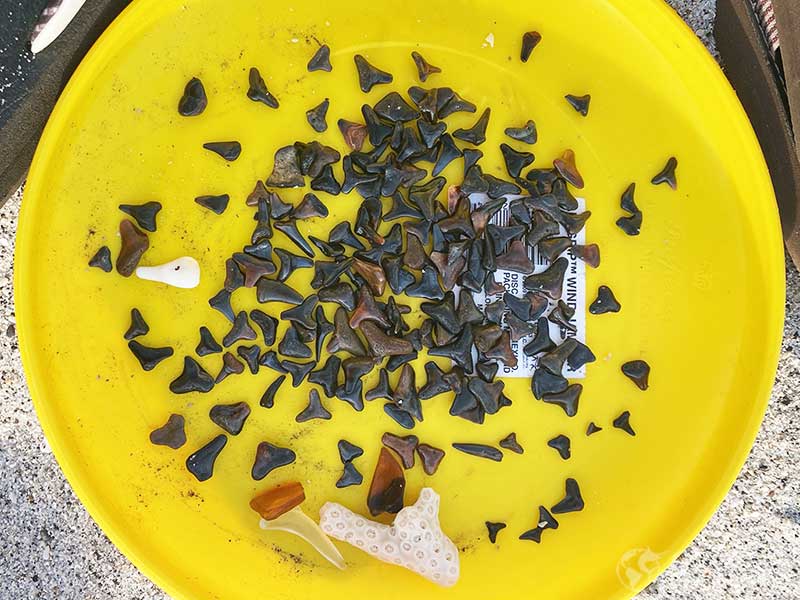Finding shark teeth at the beach is a super fun activity for people of all ages. If you know where and how to spot the teeth it is actually not difficult to find them. The last time we went to the beach with three people in south Florida we found 320 teeth in around 3 hours. This means we averaged over 30 teeth per person per hour. We found teeth using multiple techniques which will be discussed in this article.
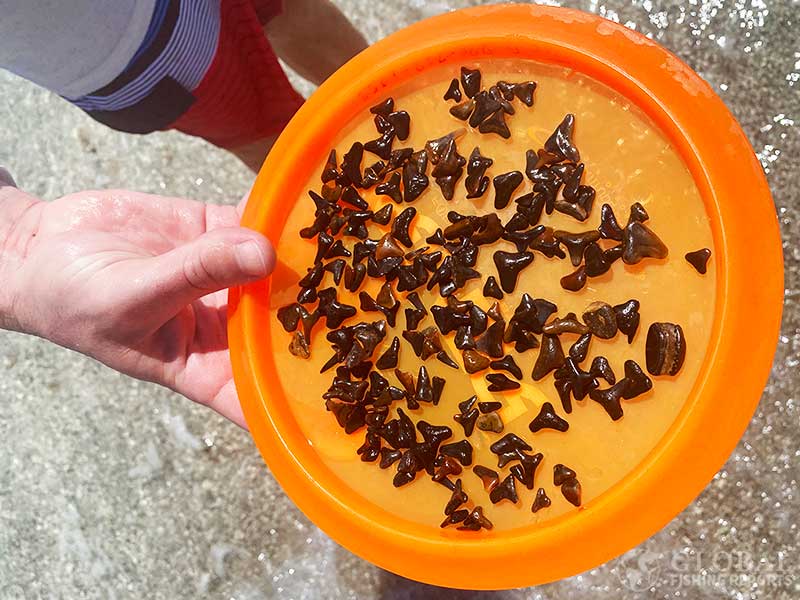
Anyone is allowed to find and keep shark teeth on public beaches in Florida. Many other types of larger fossils require special permits but there are so many shark teeth that there was an exception made to standard fossil regulations. This makes it so people can go to the beach to relax and also look for teeth as a fun activity. It is most fun when you actually find teeth so knowing the different techniques can allow you to have more success. Once people start to find them they often want to try and step up their skills to locate bigger teeth or find other unique fossils.
Walking the Beach
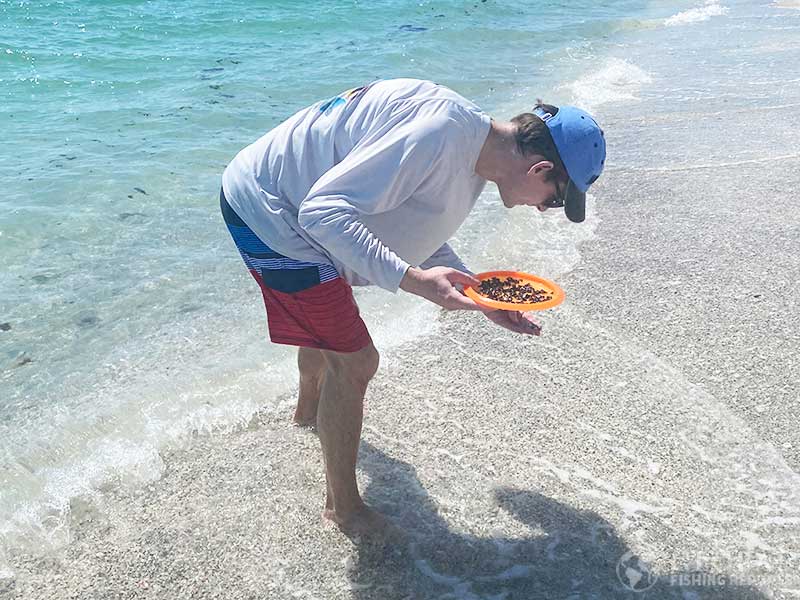
Walking the beach is the most popular way to find shark teeth. This is because it is easy and has a high chance of success. However, it does take a while to train your eyes and mind to spot teeth that are mixed in with shells, rocks, coral, and dark sand. If you do it for a few hours you might even start to look for them on your floor when you get home as well.
The best way to find shark teeth when walking the beach is to find them tumbling in the surf. After a wave crashes the beach the surf goes back and drags sand with it exposing teeth that were not able to be seen previously. Also, the teeth stand out when they are tumbling. Just make sure the water is shallow enough that it will be exposed once the wave retreats. Shark teeth are typically dark brown and in the shape of a triangle. Also, they tend to be a bit shinier than the sand and rocks.
Difficult Sand to Find Shark Teeth
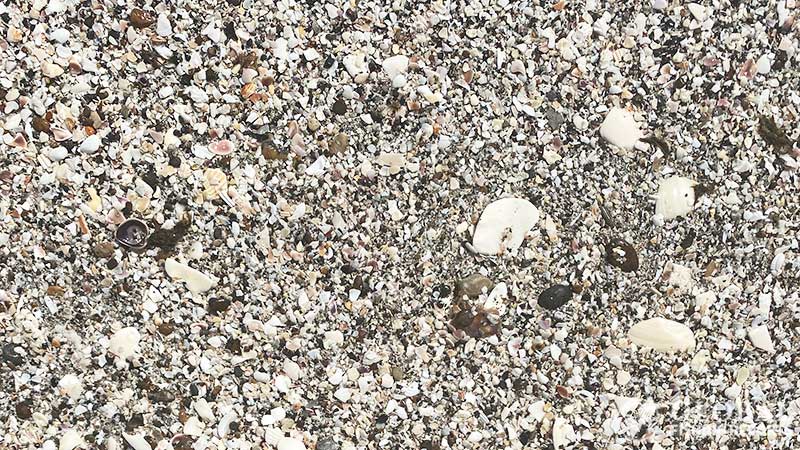
It is difficult to find shark teeth in the sand like in the photo above. This is because there are too many shells and small black rocks. It is tempting to look in these types of areas as this is where large objects congregated. Since this is the case most people would think shark teeth are also in this location. There are some shark teeth here but they are more difficult to spot among the cluttered background. I typically try to avoid this type of sand but have found some larger teeth in this type of material but not as many per hour.
Easy Sand to Find Shark Teeth
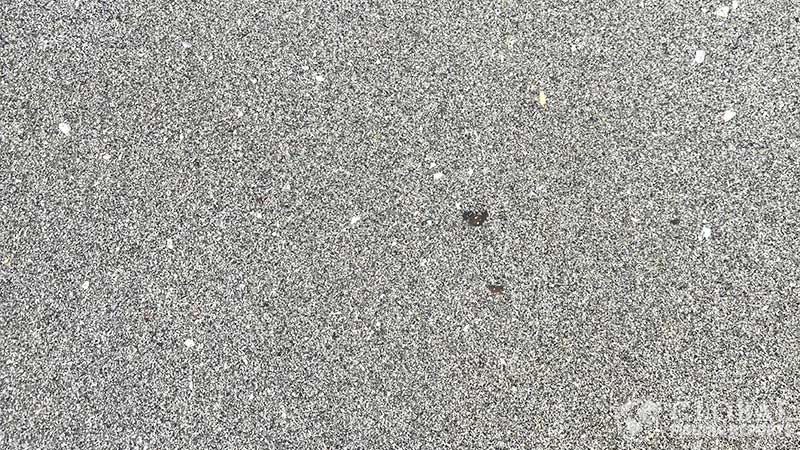
This fine sand in the surf is where I prefer to look for shark teeth. Dark objects stand out well and lots of ground can be covered quickly in theory. However, I actually like to stay in one area and have the water uncover more sand as the waves retreat from the beach.
The key to finding shark teeth is to look for really dark objects that are in the shape of a T or triangle. Shark teeth in a shark’s mouth are white and made with calcium phosphate. Shark teeth at the beach are most often really dark because they are fossilized by absorbing minerals such as iron, manganese, or other surrounding minerals in the soil.
If you look for small teeth there is a good chance you will find them, but don’t forget to also look at the larger objects as well. Some people make the mistake of only looking for large teeth and miss out on hundreds of smaller teeth they could have found.
Floating Shark Tooth Sifter
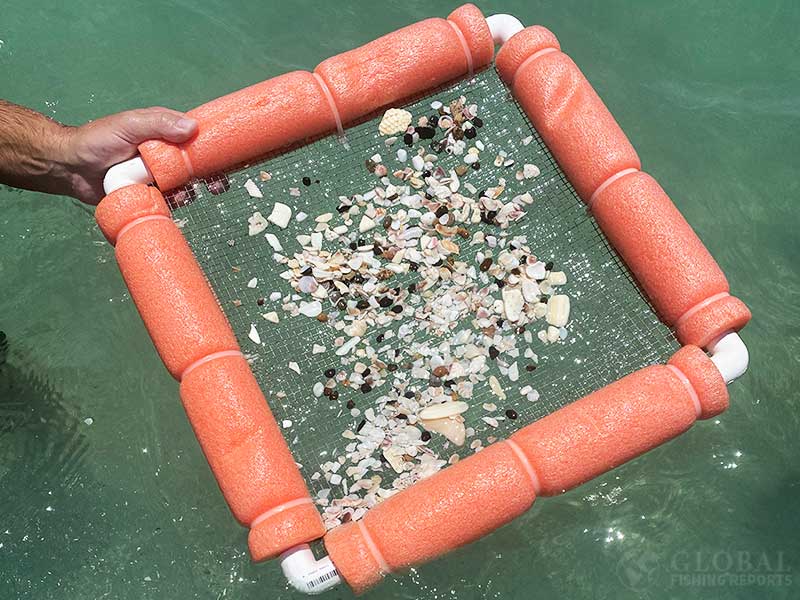
Using a floating shark tooth sifter is becoming very popular. This is because many people think this is the best way to find big shark teeth in great condition. If you go to a beach known for having shark teeth there are usually a few people in the water with the sifter. It can be attached to people with a rope and carabiner so the waves do not pull it away.
To use the sifter simply pour sand onto the top mesh. By moving the sifter back and forth the sand will fall through the cracks leaving only shells, coral, rocks, and shark teeth to look through. This makes it so the teeth can be spotted rather than buried in the sand. The shark teeth on the beach can be picked through or damaged by the surf. By going to deeper water teeth that would otherwise be difficult to see can be found.
Using a sand flea rake can be an easy way to scoop up sand from the bottom. This is because it has a long handle and filters out some of the sand before it gets to the top screen. This is good to use on calm days when the waves are not constantly crashing into you. I think you can find more teeth by just walking on the beach but you are more likely to find large unique teeth using the sifter. It is a good idea to try different areas and types of sand to see if you can locate areas with a high density of shark teeth.
Using the Surf to Expose Teeth in Buckets of Sand
Walk Into Knee-Deep Water
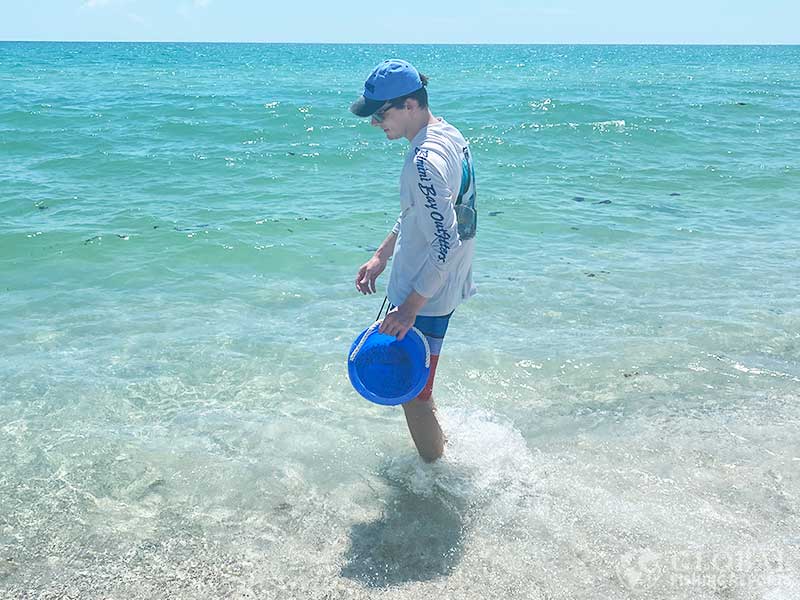
If you do not have a sifter there is another way to sort through the sand. A bucket can be used to scoop sand that is located just below the low tide line. This is where shark teeth can concentrate and most people can not look for them.
Scoop Sand Along the Ledge
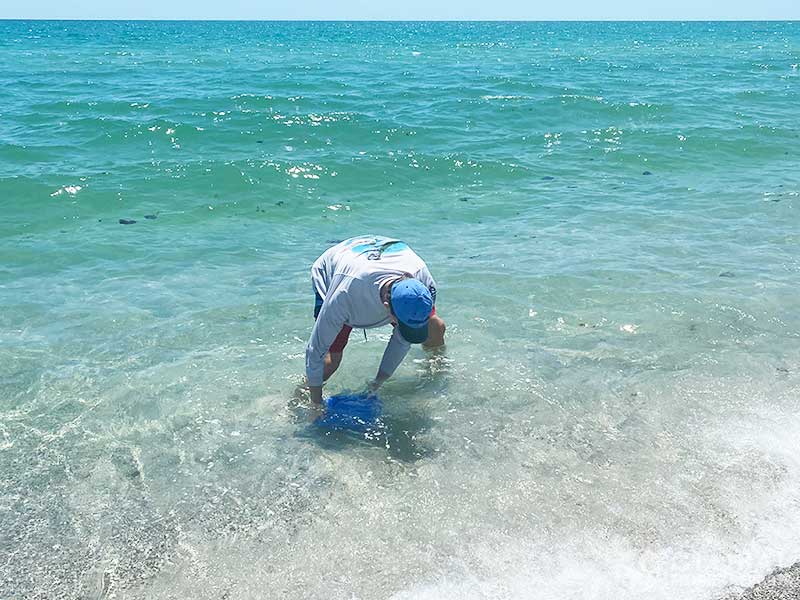
In the photo above I am scooping sand with a blue plastic bucket. I try to get sand from different depths of water to potentially find different types or sizes of teeth. Most of the time I scoop sand near the ledge of the low tide line as this is where teeth could be concentrated.
Use the Beach Surf to Filter the Sand
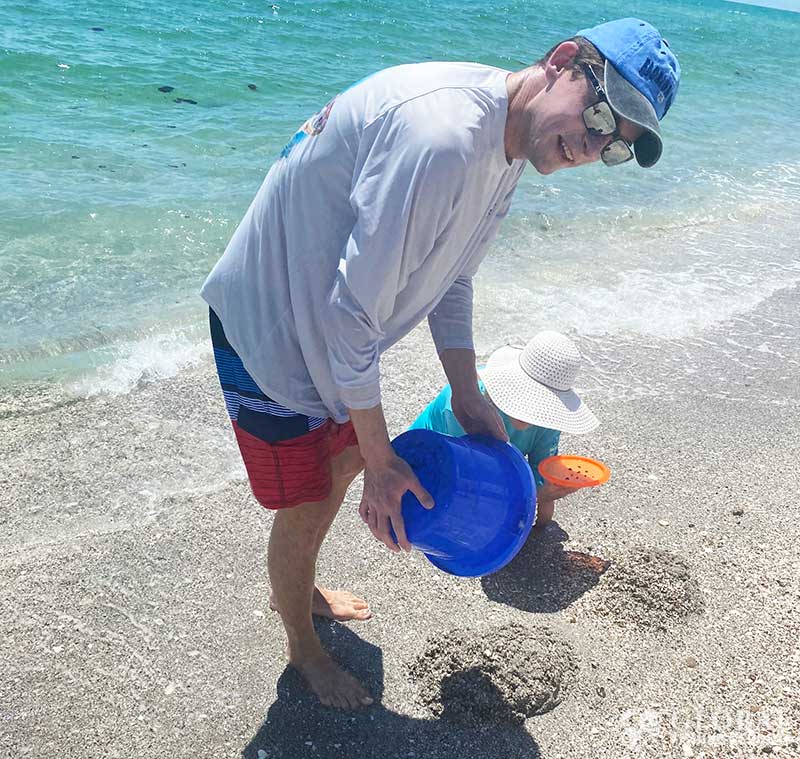
Next, the sand should be dumped at a high point on the beach but low enough that the waves still reach the sand. As the water washes over the sand and gets dispersed the teeth become exposed. You need to be on your hand and knees watching closely though. In addition to the ones you find in the sand being dumped, you can also find ones being uncovered from the main beach sand as well.
This is a simple way to find more shark teeth. Some people think you have to wait until after a storm or super low tide to find shart teeth. However, that is not the case as the sand on the beach is constantly getting washed back and forth exposing new material. The bucket method is not as easy as using a sand flea rake or sifter but definitely works to find shark teeth.
Sand Flea Rake
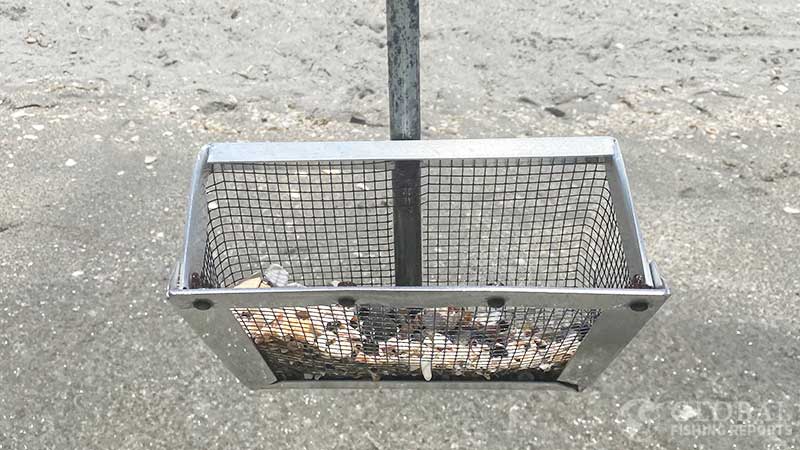
A sand flea rake is designed to catch sand fleas at the beach. Wet sand is scooped up and shaken out in the water. This leaves the sand fleas in the scoop. As a kid, we use to just dig in the sand to find plenty of sand crabs. However, if you are surf fishing then a sand flea rake can be a quick way to get natural bait.
This rake also collects shells, coral, rocks, and shark teeth. You can drag the rake in deeper water and be left only with objects large than the mesh size. Some people place this material on a sifter to sort through it. Some people dump it out under their shade umbrella and take their time looking at all the cool shells and fossils. Make sure to return the shells to the same location they were found. Leaving a pile of shells and rocks on a sandy beach is not good beach etiquette. Always try to leave the area the same or better than you found it. Throw away any trash you find while at the beach.
What To Do With Found Shark Teeth
Identify The Teeth
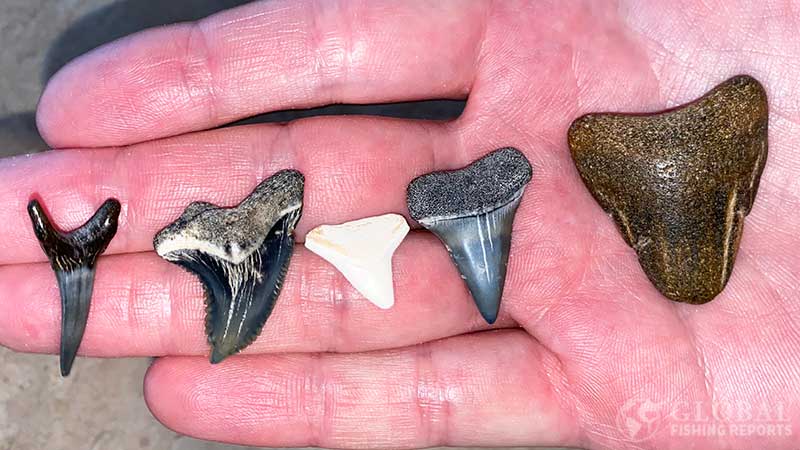
Most shark teeth can be identified by their unique shape. I wrote a separate detailed article about shark tooth identification. In the photo above from the left to right is the tooth of a sand tiger shark, snaggletooth-shark, bull shark, great white shark, crocodile teeth, mammoth ivory, and megalodon-shark.
Each type of shark has different size teeth in different areas of its jaws. Large unique teeth are easy to identify the species while smaller t-shaped teeth are common among many species of sharks. There are also over 500 different species of sharks which again can make the identification of smaller teeth more difficult. There are also other fish fossils you can find such as puffer fish mouth plates, manatee teeth, stingray teeth, barracuda teeth, whale teeth, and turtle shells.
Fossilized teeth are really cool and can be millions of years old. In Southwest Florida, the geological maps show most of the beach sediments are Holocene sediments. This would suggest that most of the teeth are around 11,700 years old. However, megalodon shark teeth have been found in these areas. The megalodon shark went extinct over 3.6 million years ago. It also lived over 23 million years ago. This suggests that many of the shark teeth found are millions of years old.
Make Artwork From the Shark Teeth
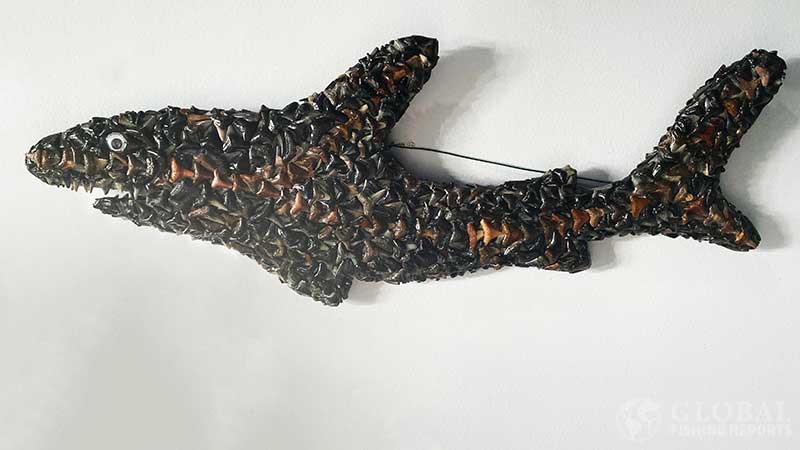
The photo above shows a decorative shark made of mostly shark teeth. Most of the teeth are small and come from lemon, blacktip, bull, and hammerhead sharks. This is just one example of what you can make with shark teeth. You could also make a necklace, bracelet, ring, or put them in a picture frame.
It is also common to store shark teeth in a glass jar. Putting shark teeth under a glass table or coffee table is another idea. Other beach items like shells and coral could also be added. A shadow box which is a thick picture frame with a glass or plastic cover could be used to make a shark tooth arrangement. A picture of the beach where the teeth were found could be used as the background to cherish your memory.
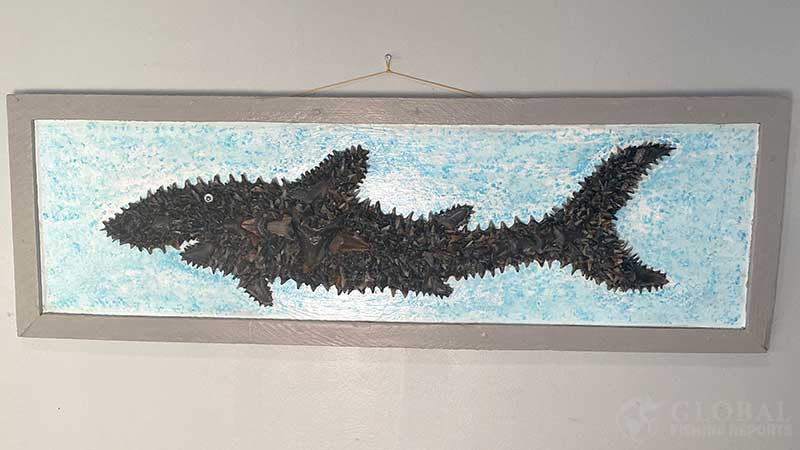
The photo above shows a shark painting where the shark is made of shark teeth. The painting is blue and white to look like the ocean.
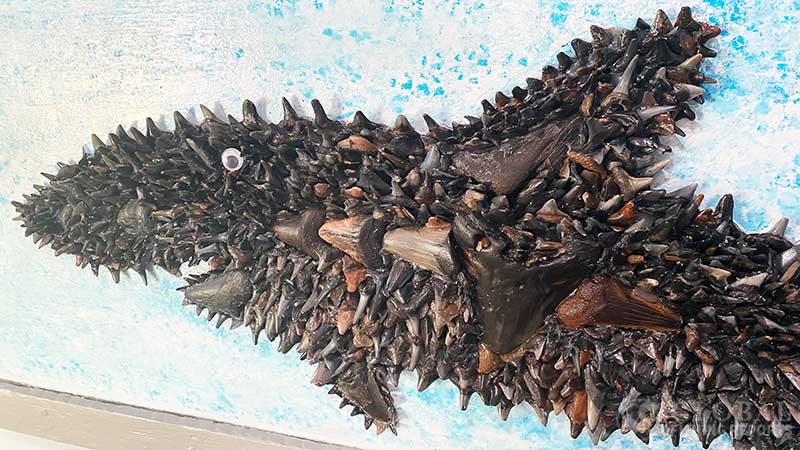
Here is a close-up view of the shark painting. This shark is made with the teeth of a megalodon, sand tiger, blacktip, lemon, tiger shark, and hammerhead shark. This makes it a really unique piece of art as many of these fossilized teeth are over 3.6 million years old. Larger teeth are used to make the various fins of the shark.
Where to Look for Shark Teeth

Shark teeth can be found at most beaches in the united states. They can also be found on land throughout most of Florida because there were times when most of Florida was underwater. This means that at times most of the land was previously a sea floor. Research articles show shorelines fluctuated significantly over the past several million years. At some points, the sea level was even 328 feet lower than today creating much more land, especially in the Gulf region where shallow water extends for many miles.
Other studies suggest that ocean levels were 22 feet higher than today during the last interglacial period which was 120,000 years ago. A fossil takes around 10,000 years to form so there are plenty of shark teeth fossils that can be found on dry land in Florida. So in some areas where they are excavating four new home construction, they will find shark teeth. These teeth belong to the land owner if they are on private land. You can get in trouble if you are fossil hunting on private land.
Since Florida was underwater for large periods of time the entire state is a popular place to look for shark teeth. Most people focus on the Beaches of Florida’s Gulf Coast although they can be found throughout the state. They can actually be found on most other beaches as well. Beaches in Georgia, South Carolina, Georgia, and Texas are also popular places to find shark teeth. The more sarks that do or did live in the area makes it more likely you will find teeth there.
If you have ever been shark fishing in Florida you know there are lots of sharks around. Florida has the highest density of sharks so it also has the highest density of shark teeth. The type and age of sediment does play into the density of shark teeth which we talked about earlier with the geological survey data. However the age of teeth found in these sediments do not always match so if you think there could be shark teeth in your area, I would suggest looking to see what you can find. At a minimum, you should be able to find some modern shark teeth if you are at any shoreline.
When Should you Look for Shark Teeth
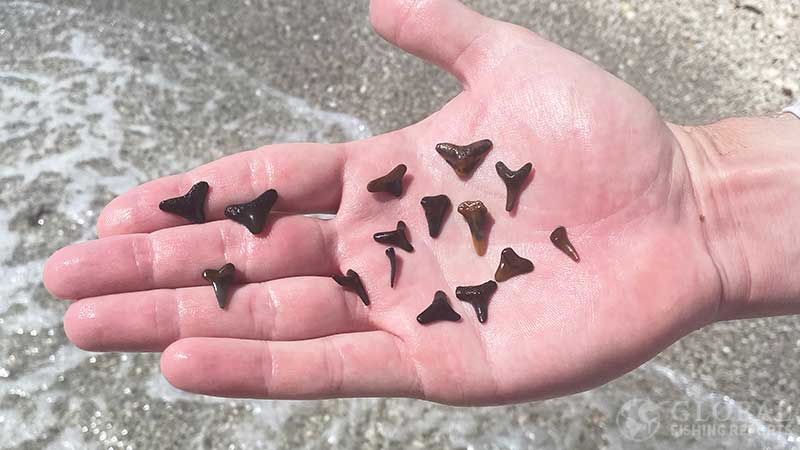
In the photo, I am holding a bunch of shark teeth we found at low-tide. When the tide is low it exposes the most amount of sand on the beach and is the best time to look for shark teeth. The tide changes about every 6 hours so there are two low tides each day. This is because there are solar and lunar tides. The time of the low tide changes each day and the time of low tide is different based on location.
So the best time to look is not in the morning or evening but is tide and wave height specific. Large waves stir up lots of sand exposing more shark teeth. Many people also suggest looking for teeth after a large storm, especially a hurricane. The storm surge and large waves bring lots of material that was in deeper water onto the beach areas. Also after hurricanes, it is common for beach excavation projects to take place where deeper sand and dirt can be dug up. Even after a thunderstorm this can happen but not to the same extent as a hurricane.
Low tides and storms can allow for a higher density of teeth to be exposed. Don’t let that stop you from looking at all times of the day. If the waves and tides are moving that means new sand is being exposed. Another good time to look is when the tide is going from high to low. As the tide line drops it should pull sand back exposing shark teeth.
Even on beaches that are loaded with people, you can still find teeth in the surf as new sand is constantly being exposed. If you think the beach is too picked through and you want to look for large teeth try and find less popular beaches or areas further from beach entrances. Walk a half-mile down the beach and then start looking.
Don’t forget to wear sunscreen as it is common to get burned when looking for shark teeth for hours. I hope this article helps you find more shark teeth. If you have other suggestions of places or ways to find teeth, leave a comment below.
Captain Cody has worked on charter fishing boats in the Florida Keys, Virgin Islands, and Alaska. Growing up in Pennsylvania Cody has also done extensive freshwater fishing including bass fishing tournaments. Cody strives to provide detailed information about the best fishing gear and tactics to help both novice and experienced anglers have a more productive and enjoyable time on the water. Cody also has a background in aerospace engineering and neuroscience but really only takes pride in being good at one thing and that is fishing!

